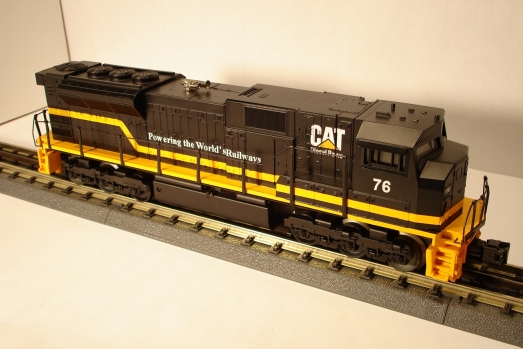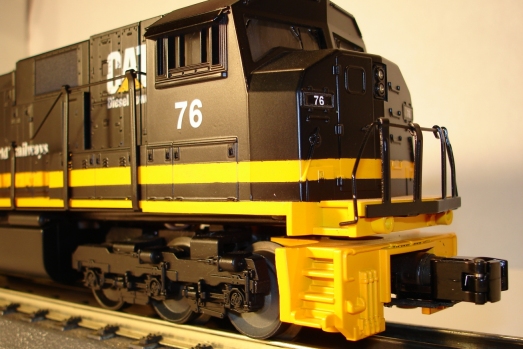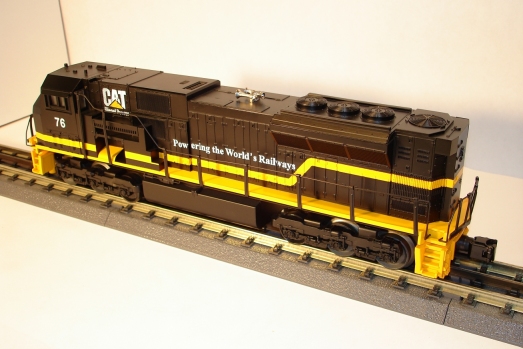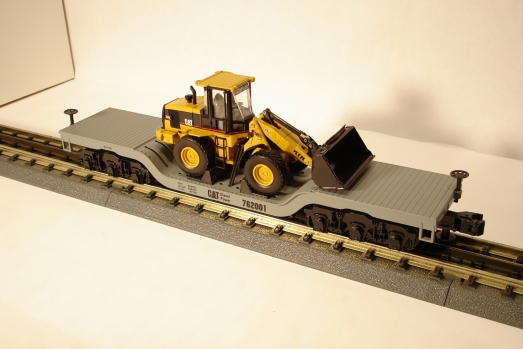There's just something about Caterpillar Inc. for me. I love the machines, the logo
and the paint schemes. What boy, of any age, doesn't get a thrill seeing
construction equipment? MTH has a pretty strong licensing deal with Caterpillar, and they make all sorts of things with both the logo/trademark, and even cooler,
articulated scale machines that are carried on train cars. We're talking well-made, die-cast earth movers, tractors, skid steers and all sorts of
construction equipment.
This engine came from a set that included just such a machine - a front loader, as well as a few cars, track, etc. I did to this one what I did with the Santa Fe,
which is clouded
the windows to hide the unfinished interior. This engine sounds great, and it has a fantastic multi-tone horn. The only real complaint is not so much that it
doesn't have a reverse headlight, but that when you do reverse it, the main headlight (which is also the cab light) goes out. It's hardly prototypical, but then
again, this is one of the lower-end PS2 engines, so what you save in money, you lose in electronic sophistication. It's a minor flaw though, because it has great
traction, double
operating couplers and as I mentioned already, the sound is awesome.
(Click on any picture to enlarge)




Here's the front loader I alluded to above
Here's some history...
The SD90MAC was introduced in 1995, along with the SD80MAC locomotives. The SD90MAC was designed to utilized the new 16-cylinder H-engine, while the SD80MAC was
designed to use the 20 cylinder version of the existing 710G engine. However, technical problems with the 6,250 horsepower (4,660 kW) engine resulted in the first
locomotives being shipped with 4,300 hp (3,210 kW) 16-cylinder 710G motors, making them similar to the SD70MACs. These locomotives were given the model SD90/43MAC
and railroads were given the option to remotor them with 6,250 hp (4,660 kW) engines when they became available.[1] This upgrade program was rarely used due to
reliability issues with the newer engine. Over 400 SD90/43MAC locomotives were built.
In 1996, EMD entered full production on their 6,250 hp (4,660 kW), 16-cylinder H-engine, and all SD90MACs made from then on used that for its prime mover.
Locomotives fitted with this engine are sometimes referred to as SD90MAC-H locomotives. Later versions of the SD90MAC-H feature a Phase II cab, with a new nose
which offers higher visibility from the cab than the old nose. The SD90MAC-H did not prove popular with railroads and less than 70 were built, including EMD
demonstrator units. Since the SD90MAC-H had such a large prime mover, it didn't offer the same operational flexibility as smaller units, limiting its possible
customer base to only the largest railroads. Also, since the H-engine was a new design it hadn't reached the same level of reliability as EMD's previous engine.
The low reliability on such a large engine was an especially bad combination since the loss of one engine in a train meant the loss of a larger percentage of
pulling power than had a smaller engine failed. In the end the SD90MAC-H was only delivered to two railroads, the Union Pacific Railroad and the Canadian Pacific
Railway.[1] The Canadian Pacific locomotives were part of an earlier order for SD90/43MAC locomotives that was still in production when EMD switched over to the
H-engine.
EMD also tried offering a lower-power version of the SD90MAC with a 12-cylinder engine called the SD89MAC, but none were produced other than the prototype.
|

